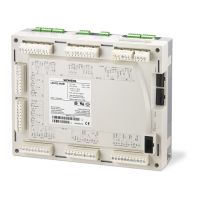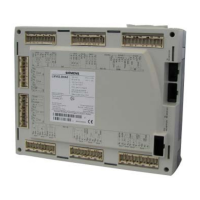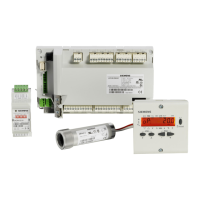Do you have a question about the Siemens LMV51.300B2 and is the answer not in the manual?
Describes the LMV52's capability for additional O2 trim control for enhanced efficiency.
Essential warnings for safe operation, installation, and service of the LMV5 system.
Notes on electrical wiring, installation practices, and compliance with safety regulations.
Guidelines for adjusting and setting parameters to ensure correct operation and safety.
Detailed description of the burner control's inputs and outputs, including flame signal and digital inputs.
Details on connection facilities for various flame detectors like QRI, ionization probe, QRB, QRA.
Covers separate flame supervision capabilities for LMV50 and LMV52, including parameter settings.
How to perform flame supervision using an external, approved flame safeguard.
Description of various digital inputs used for safety and control functions.
Details on the safety loop input, its function, and typical contacts included.
Procedures for manually locking the system and resetting lockouts or faults.
Configuration options for gas pressure switch, valve proving, or CPI inputs.
Description of safety-related (SI) and non-safety-related (No-SI) digital outputs.
Details on the burner control sequence and its stages.
Setting reaction time for flame loss and safety time during operation.
Procedure and parameters for gas valve proving, active only during gas firing.
Defines addresses assigned to dampers and actuators for fuel-air ratio control.
Procedures for activating or deactivating actuators, including auxiliary and VSD functions.
Description of the control sequence and how actuators advance through program phases.
Definition of safety time for fuel-air ratio control and its dynamic implementation.
Overview of the LMV5's integrated PID boiler temperature or pressure controller.
Details on operating modes for load controllers, including internal, external, and BACS configurations.
Defining burner operation mode as manual, automatic, or off, and related parameters.
Load controller operating modes (modulating, multistage) and electronic fuel-air ratio control.
Details of the integrated 2-position controller and its heat request information.
Functionality of modulating control, including PID algorithm and examples.
How to manually set PID parameters like proportional band, integral action time, and derivative action time.
Using the adaption function for PID parameters based on acquired system data.
Configuration for 2-stage or 3-stage operation and load-dependent activation of stages.
Definition of sensors and their activation/deactivation for temperature limiter function.
Adjusting 2 setpoints (W1, W2) via AZL5 and external contacts.
Safety-related function to limit temperature, working like a 2-position controller.
Function to protect against thermal shock during cold starts, with modulating and multistage control.
Setting output steps for CSTP in modulating operation, defining stages and load values.
CSTP for multistage control, defining output steps based on burner stages and locking options.
Details the assignment of terminals for CAN, COM1, and COM2 interfaces on the AZL5.
Describes the three ports (LMV5 CAN, PC RS-232, BACS e-bus) and their functions.
Communication with BACS via data link and external bus interface (COM2).
Overview of displays and settings available on the AZL5.
Visual representation of the AZL5 menu structure for navigation and parameter access.
Important displays in normal operation, including examples of lockout and start prevention messages.
Information on lockout and error messages, including examples of their display.
Procedure for selecting main menu items and entering passwords for parameter access.
How to address actuators and assign their functions via the AZL5 menu.
Detailed guide on parameterizing fuel-air ratio control curves using various methods.
Method for editing individual curvepoints by acknowledging the pointer and selecting points.
Adjusting burner curves in manual operation with optional point storage.
Sequence steps for adapting PID parameters (self-setting) of the load controller.
Information on the TÜV test function, including loss-of-flame and safety limit thermostat tests.
Step-by-step guide for basic system configuration, including burner identification and fuel train selection.
Setting fuel-air ratio control for gas-fired operation, including program stops and ignition positions.
Settings for multistage oil-fired operation, covering fuel changeover and operation mode.
Details on powering the LMV5 via external transformer AGG5.2 and bus topology.
General notes on electrical installation, wiring practices, and safety precautions.
Details on powering the LMV5 via external transformer AGG5.2 and bus topology.
Responsibilities of authorized inspectors regarding compliance, component specifications, and checks.
Documentation of parameterized values for fuel-air ratio control and O2 trim control.
Importance of setting values for actuators, fuel types, and combustion air for correct operation.
Technical specifications for LMV5 and AZL5, including mains voltage, frequency, and power consumption.
Details on loads on terminals, primary/unit fuses, and mains supply characteristics.
Detailed description of the VSD module's functionality and connections.
Description of inputs and outputs for the VSD module, including motor speed and release contact.
Configuration steps for the VSD module, including acceleration/deceleration ramps and motor speed.
How to configure the speed sensor and motor speed acquisition for the VSD.
Automatic measurement function for standardizing VSD speed, including parameter settings.
Introduction to LMV52 features including O2 trim control, VSD control, and QGO20/PLL52 integration.
How the O2 trim control system reduces combustion air based on control deviation.
Operating modes of O2 trim controller and alarm, including activation and deactivation.
Activating/deactivating O2 trim control or alarm via parameter settings and operating modes.
Using O2 alarm with or without O2 trim control, defining thresholds for min/max values.
Criteria for O2 minimum and maximum value alarms and reactions based on operating mode.
Procedure to detect aging of the QGO20 sensor by measuring internal resistance.
Connecting PLL52 and QGO20 for residual oxygen control on LMV52.
Configuring connected sensors (QGO20, air/flue gas temp sensors) via AZL5.
Activating/deactivating actuators and VSDs, parameterizing air-influencing actuators for O2 trim control.
Step-by-step instructions for commissioning the O2 trim control system.
Adjusting ratio control curves, ensuring excess O2, and parameterizing loads proportionally.
Adjusting O2 alarm settings, initially deactivating it to avoid undesired responses.
Setting O2 trim control, ensuring O2 alarm is active, and adjusting parameters like LowfireAdaptPtNo.
Setting excess O2 and ensuring linear O2 value progression between curvepoints.
Setting O2 min. value, ensuring adequate distance from O2 setpoint, and adjusting under same conditions.
How FGR reduces NOx content by feeding flue gas back to combustion chamber.
Setting fuel-air ratio control with FGR, including modes without and with temperature compensation.
Setting FGR curves in temperature-compensated mode for LMV52.4.
Describes the LMV52's capability for additional O2 trim control for enhanced efficiency.
Essential warnings for safe operation, installation, and service of the LMV5 system.
Notes on electrical wiring, installation practices, and compliance with safety regulations.
Guidelines for adjusting and setting parameters to ensure correct operation and safety.
Detailed description of the burner control's inputs and outputs, including flame signal and digital inputs.
Details on connection facilities for various flame detectors like QRI, ionization probe, QRB, QRA.
Covers separate flame supervision capabilities for LMV50 and LMV52, including parameter settings.
How to perform flame supervision using an external, approved flame safeguard.
Description of various digital inputs used for safety and control functions.
Details on the safety loop input, its function, and typical contacts included.
Procedures for manually locking the system and resetting lockouts or faults.
Configuration options for gas pressure switch, valve proving, or CPI inputs.
Description of safety-related (SI) and non-safety-related (No-SI) digital outputs.
Details on the burner control sequence and its stages.
Setting reaction time for flame loss and safety time during operation.
Procedure and parameters for gas valve proving, active only during gas firing.
Defines addresses assigned to dampers and actuators for fuel-air ratio control.
Procedures for activating or deactivating actuators, including auxiliary and VSD functions.
Description of the control sequence and how actuators advance through program phases.
Definition of safety time for fuel-air ratio control and its dynamic implementation.
Overview of the LMV5's integrated PID boiler temperature or pressure controller.
Details on operating modes for load controllers, including internal, external, and BACS configurations.
Defining burner operation mode as manual, automatic, or off, and related parameters.
Load controller operating modes (modulating, multistage) and electronic fuel-air ratio control.
Details of the integrated 2-position controller and its heat request information.
Functionality of modulating control, including PID algorithm and examples.
How to manually set PID parameters like proportional band, integral action time, and derivative action time.
Using the adaption function for PID parameters based on acquired system data.
Configuration for 2-stage or 3-stage operation and load-dependent activation of stages.
Definition of sensors and their activation/deactivation for temperature limiter function.
Adjusting 2 setpoints (W1, W2) via AZL5 and external contacts.
Safety-related function to limit temperature, working like a 2-position controller.
Function to protect against thermal shock during cold starts, with modulating and multistage control.
Setting output steps for CSTP in modulating operation, defining stages and load values.
CSTP for multistage control, defining output steps based on burner stages and locking options.
Details the assignment of terminals for CAN, COM1, and COM2 interfaces on the AZL5.
Describes the three ports (LMV5 CAN, PC RS-232, BACS e-bus) and their functions.
Communication with BACS via data link and external bus interface (COM2).
Overview of displays and settings available on the AZL5.
Visual representation of the AZL5 menu structure for navigation and parameter access.
Important displays in normal operation, including examples of lockout and start prevention messages.
Information on lockout and error messages, including examples of their display.
Procedure for selecting main menu items and entering passwords for parameter access.
How to address actuators and assign their functions via the AZL5 menu.
Detailed guide on parameterizing fuel-air ratio control curves using various methods.
Method for editing individual curvepoints by acknowledging the pointer and selecting points.
Adjusting burner curves in manual operation with optional point storage.
Sequence steps for adapting PID parameters (self-setting) of the load controller.
Information on the TÜV test function, including loss-of-flame and safety limit thermostat tests.
Step-by-step guide for basic system configuration, including burner identification and fuel train selection.
Setting fuel-air ratio control for gas-fired operation, including program stops and ignition positions.
Settings for multistage oil-fired operation, covering fuel changeover and operation mode.
Details on powering the LMV5 via external transformer AGG5.2 and bus topology.
General notes on electrical installation, wiring practices, and safety precautions.
Details on powering the LMV5 via external transformer AGG5.2 and bus topology.
Responsibilities of authorized inspectors regarding compliance, component specifications, and checks.
Documentation of parameterized values for fuel-air ratio control and O2 trim control.
Importance of setting values for actuators, fuel types, and combustion air for correct operation.
Technical specifications for LMV5 and AZL5, including mains voltage, frequency, and power consumption.
Details on loads on terminals, primary/unit fuses, and mains supply characteristics.
Detailed description of the VSD module's functionality and connections.
Description of inputs and outputs for the VSD module, including motor speed and release contact.
Configuration steps for the VSD module, including acceleration/deceleration ramps and motor speed.
How to configure the speed sensor and motor speed acquisition for the VSD.
Automatic measurement function for standardizing VSD speed, including parameter settings.
Introduction to LMV52 features including O2 trim control, VSD control, and QGO20/PLL52 integration.
How the O2 trim control system reduces combustion air based on control deviation.
Operating modes of O2 trim controller and alarm, including activation and deactivation.
Activating/deactivating O2 trim control or alarm via parameter settings and operating modes.
Using O2 alarm with or without O2 trim control, defining thresholds for min/max values.
Criteria for O2 minimum and maximum value alarms and reactions based on operating mode.
Procedure to detect aging of the QGO20 sensor by measuring internal resistance.
Connecting PLL52 and QGO20 for residual oxygen control on LMV52.
Configuring connected sensors (QGO20, air/flue gas temp sensors) via AZL5.
Activating/deactivating actuators and VSDs, parameterizing air-influencing actuators for O2 trim control.
Step-by-step instructions for commissioning the O2 trim control system.
Adjusting ratio control curves, ensuring excess O2, and parameterizing loads proportionally.
Adjusting O2 alarm settings, initially deactivating it to avoid undesired responses.
Setting O2 trim control, ensuring O2 alarm is active, and adjusting parameters like LowfireAdaptPtNo.
Setting excess O2 and ensuring linear O2 value progression between curvepoints.
Setting O2 min. value, ensuring adequate distance from O2 setpoint, and adjusting under same conditions.
How FGR reduces NOx content by feeding flue gas back to combustion chamber.
Setting fuel-air ratio control with FGR, including modes without and with temperature compensation.
Setting FGR curves in temperature-compensated mode for LMV52.4.
| Brand | Siemens |
|---|---|
| Model | LMV51.300B2 |
| Category | Control Unit |
| Language | English |












